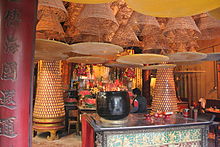| A-Má Temple | |
|---|---|
| 媽閣廟 | |
 A-Má Temple, Macau A-Má Temple, Macau | |
| General information | |
| Location | Barra, Macau |
| Town or city | Macau |
| Country | Macau |
| Completed | 1488 |
| A-Ma Temple | |||||||||||||||||
|---|---|---|---|---|---|---|---|---|---|---|---|---|---|---|---|---|---|
 Main Hall Main Hall | |||||||||||||||||
| Chinese name | |||||||||||||||||
| Traditional Chinese | 媽閣廟 | ||||||||||||||||
| Simplified Chinese | 妈阁庙 | ||||||||||||||||
| Literal meaning | Temple of the Pavilion of the Mother | ||||||||||||||||
| |||||||||||||||||
| Portuguese name | |||||||||||||||||
| Portuguese | Templo de A-Má | ||||||||||||||||
The A-Má Temple is a temple to the Chinese sea-goddess Mazu located in São Lourenço, Macau, China. Built in 1488, the temple is one of the oldest in Macau and thought to be the settlement's namesake.
History
The name Macau was thought to be derived from the name of the temple. See Hokkien Chinese: 阿媽; Pe̍h-ōe-jī: a-má; lit. 'grandmother', 'elderly woman'; Cantonese Chinese: 阿媽; Jyutping: aa maa; Cantonese Yale: a máh; lit. 'an epithet of the Fujianese sea goddess Matsu (媽祖)'. It is said that when the Portuguese sailors landed at the coast just outside the temple and asked the name of the place, the natives replied A-maa-gok (Cantonese Chinese: 阿媽閣; Jyutping: aa maa gok; Cantonese Yale: a máh gok; lit. 'Pavillion of the Fujianese sea goddess Matsu (媽祖)'; Hokkien Chinese: 阿媽閣; Pe̍h-ōe-jī: A-má Koh; lit. 'Ornamental Platform of the Grandmother') or Maa-gok (Cantonese Chinese: 媽閣; Jyutping: maa gok; Cantonese Yale: máh gok; lit. 'Pavillion of the Mother'). The Portuguese then named the peninsula with various forms over the centuries such as "Amacão", "Ama Cuão", "amaquan", "Amacao", "Amacuão", "Amaquão", "Amangão", "Amagão", "Amaquam", then the initial ⟨A⟩ was later elided in Portuguese likely due to misconstruing with Portuguese: a, lit. 'towards; to; at; in' resulting into the following forms, "Macão", "Macao", "Macau", "Maquão", "Maçhoam", "Machoam". The temple was well described in ancient Chinese texts as well as represented in paintings, related to Macao. It is also one of the first scenes photographed in Macao.
In 2005, the temple became one of the designated sites of the Historic Centre of Macau, a UNESCO World Heritage Site.
Architecture
The temple consists of six main parts: Gate Pavilion, the Memorial Arch, the Prayer Hall, the Hall of Benevolence (the oldest part of the temple), the Hall of Guanyin, Zhengjiao Chanlin - Buddhist Pavilion.
Gallery
-
 A 19th-century painting of the facade of A-Ma Temple by English architect and artist Thomas Allom
A 19th-century painting of the facade of A-Ma Temple by English architect and artist Thomas Allom
-
 Main entrance of A-Ma Temple
Main entrance of A-Ma Temple
-
World Heritage marker
-
 Prayer Hall
Prayer Hall
-
 Hall of Benevolence
Hall of Benevolence
-
 Zhengjiao Chanlin Buddhist Temple
Zhengjiao Chanlin Buddhist Temple
See also
- Kun Iam Temple, built in 1627
- Tam Kung Temple (Macau), built in 1862
- Na Tcha Temple, built in 1888
- Sam Kai Vui Kun
- Tin Hau temples in Hong Kong
- Qianliyan & Shunfeng'er
- Religion in Macau
- List of historic buildings and structures in Macau
References
- "Hakka and Macau" (in Chinese). Archived from the original on 13 January 2008. Retrieved 2008-01-02.
- "A-Ma Temple". Wondermondo. 14 November 2014.
22°11′10″N 113°31′52.10″E / 22.18611°N 113.5311389°E / 22.18611; 113.5311389
| São Lourenço, Macau | |
|---|---|
| Geography | |
| Gov't | |
| Landmarks | |
| Transport | |
| Education | |
This article about a Macau building or structure is a stub. You can help Misplaced Pages by expanding it. |
This article about a Chinese religious building or structure is a stub. You can help Misplaced Pages by expanding it. |
- Buildings and structures completed in 1488
- Religious buildings and structures completed in the 1480s
- Historic Centre of Macau
- Macau Peninsula
- Buddhist temples in Macau
- Landmarks in Macau
- Mazu temples
- 1488 establishments in Asia
- 15th-century establishments in China
- 15th-century Buddhist temples
- Classified immovable properties
- Asian building and structure stubs
- Macau stubs
- People's Republic of China religious building and structure stubs